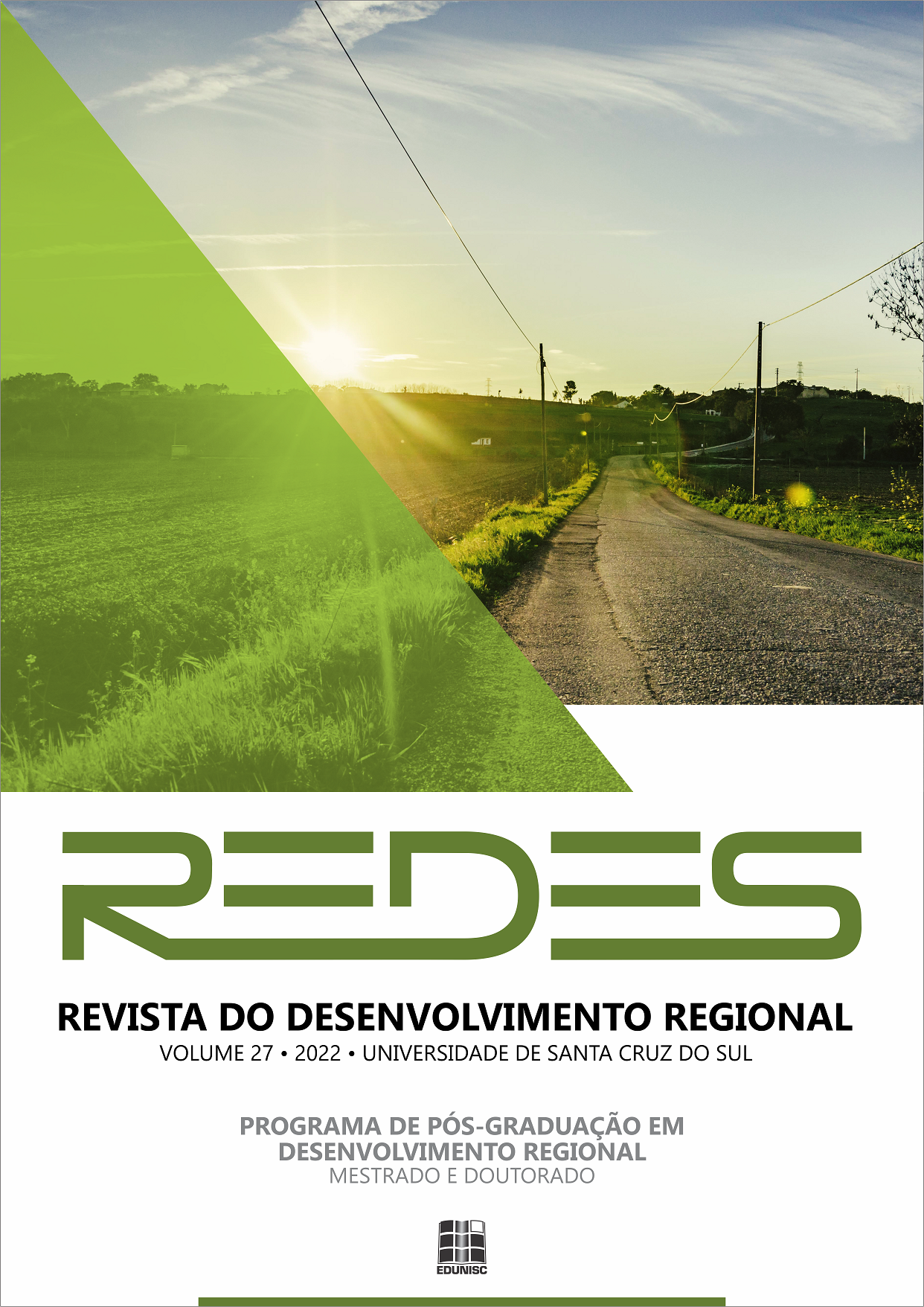Skin neoplasm in a reference hospital of Campos dos Goytacazes municipality: record integration and its interface with the health policy
DOI:
https://doi.org/10.17058/redes.v27i.16943Keywords:
Basal cell carcinoma, Squamous cell carcinoma, Public policy, Melanoma, Skin cancerAbstract
Given its importance and multidimensionality, health plays an essential role in the public policy field. Skin cancer is the most common type of neoplasm found in Brazil and is considered a public health problem. In this regard, this research addresses the issue of skin cancer with a diagnosis of its incidence in the municipality of Campos dos Goytacazes, Rio de Janeiro State, Brazil, based on the Hospital Cancer Registry (RHC, abbreviation in Portuguese). These records obtained data from all patients seen at a reference hospital (Hospital Escola Álvaro Alvim) who were diagnosed with skin cancer between 2012 and 2017, totaling 656 cases. A descriptive statistical analysis of variables such as age, occupation, tumor location, neighborhood, and gender was used to profile skin cancer patients in the municipality, identifying the sectors of the area where the local population is most affected by the disease, besides any environmental factors that may be related and the most affected race. The results of the study demonstrate that the light-skinned population (69.1%) and the age group over 55 years old (predominantly from 70 to 74 years for basal cell carcinomas and from 80 to 84 years for squamous cell carcinomas) constitute the most affected group by skin cancer. This information should support public policies and campaigns among the population aiming to improve strategies for its prevention and early diagnosis.
Downloads
References
AZULAY, R.D; AZULAY, D.R. Neoplasias epiteliais. In: AZULAY, R.D (ed.); AZULAY, D.R (ed). Dermatologia. 4 ed. Rio de Janeiro: Guanabara Koogan, 2006. p. 510-26.
______. Dermatologia. 4. ed. Rio de Janeiro: Guanabara Koogan, 2006.
AMERICAN CANCER SOCIETY. Cancer facts and figures 2016. Disponível em: <https://www.cancer.org/content/dam/cancer-org/research/cancer-facts-and-statistics/annual-cancer-facts-and-figures/2016/cancer-facts-and-figures-2016.pdf>. Acesso em: 01 jul 2019.
BRAY, Freddie; FERLAY, Jacques; SOERJOMATARAM, Isabelle; SIEGEL, Rebecca L.; TORRE, Lindsey A.; JEMAL, Ahmedin. Global cancer statistics 2018: globocan estimates of incidence and mortality worldwide for 36 cancers in 185 countries. Ca: A Cancer Journal for Clinicians, v. 68, n. 6, p. 394-424, 12 set. 2018.
CAMERON, Michael C.; LEE, Erica; HIBLER, Brian P.; BARKER, Christopher A.; MORI, Shoko; CORDOVA, Miguel; NEHAL, Kishwer S.; ROSSI, Anthony M.. Basal cell carcinoma. Journal of The American Academy of Dermatology, v. 80, n. 2, p. 303-317, 2019.
CHINEM, Valquiria Pessoa; MIOT, Hélio Amante. Epidemiology of basal cell carcinoma. Anais Brasileiros de Dermatologia, Rio de Janeiro, v. 86, n. 2, p. 292-305, 2011.
FERLAY, J.; COLOMBET, M.; SOERJOMATARAM, I.; MATHERS, C.; PARKIN, D.M.; PIÑEROS, M.; ZNAOR, A.; BRAY, F.. Estimating the global cancer incidence and mortality in 2018: globocan sources and methods. International Journal Of Cancer, v. 144, n. 8, p. 1941-1953, 2018.
GUERRA, Maximiliano Ribeiro; GALLO, Cláudia Vitória de Moura; MENDONÇA, Gulnar Azevedo e Silva. Risco de câncer no Brasil: tendências e estudos epidemiológicos mais recentes. Revista Brasileira de Cancerologia, Rio de Janeiro, v. 51, n. 3, p. 227-234, 2005.
INSTITUTO BRASILEIRO DE GEOGRAFIA E ESTATÍSTICA. SIDRA: Sistema do Instituto Brasileiro de Geografia e Estatística de Recuperação Automática. Rio de Janeiro: IBGE, 2020. Disponível em: www.sidra.ibge.gov.br>Acesso em 25/jul/2020.
INSTITUTO NACIONAL DE CÂNCER JOSÉ ALENCAR GOMES DA SILVA (INCA). Dados de epidemiologia do câncer na Internet: acesso durante o ano 2020. Rio de Janeiro: INCA, 2020. Disponível em: <http://www.inca.org.br>. Acesso em: 08 Ago 2020.
______. Estimativas 2018: Incidência de Câncer no Brasil. Rio de Janeiro: INCA, 2019: Disponível em: <http://www1.inca.gov.br/inca/Arquivos/estimativa-2018.pdf>. Acesso em: 24 jun 2019.
LEITER, Ulrike; EIGENTLER, Thomas; GARBE, Claus. Epidemiology of Skin Cancer. Sunlight, Vitamin D And Skin Cancer, p. 120-140, 2014.
NARAYANAN, Deevya L.; SALADI, Rao N.; FOX, Joshua L.. Review: ultraviolet radiation and skin cancer. International Journal of Dermatology, v. 49, n. 9, p. 978-986, 2010.
RIBERO, Simone; STUCCI, Luigia S.; MARRA, Elena; MARCONCINI, Riccardo; SPAGNOLO, Francesco; ORGIANO, Laura; PICASSO, Virginia; QUEIROLO, Paola; PALMIERI, Guiseppe; QUAGLINO, Pietro; BATAILLE, Veronique. Effect of Age on Melanoma Risk, Prognosis and Treatment Response. Acta Dermato Venereologica, v. 98, n. 7, p. 624-629, 2018.
SENA, Jéssica Suellen; GIRÃO, Régio José Santiago; CARVALHO, Sionara Melo Figueiredo de; TAVARES, Rosielly Melo; FONSECA, Fernando Luiz Affonso; SILVA, Patrícia Barros Aquino; BARBOSA, Maria Clara Fortes Portela. Occupational skin cancer: systematic review. Revista da Associação Médica Brasileira, São Paulo, v. 62, n. 3, p. 280-286, 2016.
THOMAS-GAVELAN, Elizabeth; SÁENZ-ANDUAGA, Eliana; RAMOS, Willy; SÁNCHEZ-SALDAÑA, Leonardo; SIALER, María del Carmen. Knowledge, attitudes and practices about sun exposure and photoprotection in outpatients attending dermatology clinics at four hospitals in Lima, Peru. Anais Brasileiros de Dermatologia, Rio de Janeiro, v. 86, n. 6, p. 1122-1128, 2011.
TRAKATELLI, M.; BARKITZI, K.; APAP, C.; MAJEWSKI, S.; VRIES, E. de. Skin cancer risk in outdoor workers: a european multicenter case-control study. Journal of The European Academy of Dermatology and Venereology, v. 30, p. 5-11, 2016.



